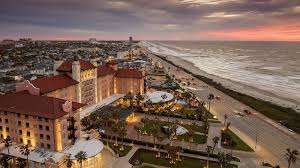Galveston Island stretches along the Texas coast, a thin ribbon of land cradled by the Gulf of Mexico, its edges worn smooth by waves that have seen centuries come and go. It’s a place that feels alive with memory—27 miles long, barely three wide—where the ghosts of a once-thriving port mingle with the salt air. Back in its heyday, it nearly outshone New Orleans, until the 1900 hurricane roared in, stealing 8,000 lives and rewriting its fate. What rose from that wreckage is a Galveston of stubborn grace, its old homes standing tall, its beaches calling out to anyone willing to listen to the stories carried on the breeze.
Notable Insight: They say Galveston threw the first beach bash in America, way back in 1881. Picture it: folks gathered under a solstice moon, fires crackling, voices lifting in song—a spark of joy that’s never quite left the island’s soul.
Places to Visit: An Overview
Galveston lays out its treasures like a well-loved book, each page turned revealing something worth lingering over. The Strand Historic District is where you start, a stretch of streets lined with buildings that have stood since the 1800s, their iron fronts and brick walls now sheltering little shops and places to eat. You can almost hear the clop of hooves from the days when cotton bales piled high along the docks. Then there’s the Galveston Island Historic Pleasure Pier, reaching out into the water, its lights flickering as the Ferris wheel spins and kids chase after sugary treats—a bright echo of the island’s knack for fun.
If you’re the sort who likes the wilder side of things, Galveston Island State Park waits with its sandy hills and marshy patches, where birds dip low and the wind hums through the grass. The Moody Mansion pulls you back in time, a big, brooding house from 1895, all dark stone and polished wood inside—step in, and you’re brushing against the lives of people long gone. Over at Seawolf Park, you can climb aboard a submarine and a destroyer from the Second World War, their metal cool under your hands, heavy with the weight of what they’ve seen.
The beaches are the heart of it—Stewart Beach calm and easy, East Beach buzzing with life. Every spot here holds a piece of Galveston’s tale, stitched together with grit and salt.
How to Reach
Getting to Galveston is a straightforward affair, just 50 miles down the road from Houston. Interstate 45 takes you straight there, over a causeway where the city fades and the water opens up. It’s an hour if you’re lucky, longer when the summer crowds clog the way, so I’d say set out early, catch the morning light on the bay.
Flying in? Houston’s got you covered with two airports. George Bush Intercontinental (IAH) is 70 miles off, a bit of a haul, while William P. Hobby (HOU) sits closer at 40. Rent a car if you like the freedom—I do—or hop the Galveston Express shuttle to roll right into town. There’s an Amtrak stop in Houston too, with a bus to finish the trip. Once you’re on the island, it’s small enough to wander on foot, though one can find a bike or the trolley handy for stretching out farther.
Frequently Asked Questions About Galveston’s Cultural Heritage
People always want to know what makes Galveston tick, and it’s the history that keeps coming up. Here’s what I’ve pieced together from asking around and digging in.
What’s the story behind its start?
It kicked off in 1839 as a port, busy and bold, until that 1900 storm hit. After that, it found its footing again, and in 1865, it gave us Juneteenth—freedom’s first word to Texas slaves.
Why all the fancy old buildings?
After the hurricane, money flowed in, and folks built big—Victorian houses and storefronts that stuck around as the island turned to visitors instead of ships.
Pirates—really?
Oh, yes. Jean Lafitte ran the show here in the 1810s, a rogue with a taste for trouble. He left in 1821, chased off, but some swear his loot’s still buried out there.
Juneteenth started here?
Right on the dot—June 19, 1865, a Union general stood in Galveston and read out the news: slavery was done. It’s a day that’s grown beyond the island now.
Beyond the Surface
There’s more to Galveston if you’re willing to look. The Ocean Star Offshore Drilling Rig Museum sits out in the water, a hulking thing of steel where you can walk the deck and hear how oil shaped this coast. The Bryan Museum is quieter, tucked in an old building, full of odd bits like handwritten letters and cowboy gear that make you feel the West breathing.
The Seawall is my evening haunt—10 miles of it, painted with fish and boats, holding the Gulf at bay. You can eat at The Spot, shrimp fresh off the line, the view stretching out forever, or grabbed a beer at Galveston Island Brewing, tasting the salt in the air. The Bishop’s Palace looms nearby, all stone and secrets—step inside, and the past wraps around you.
Kids love Schlitterbahn Waterpark, splashing down slides, while the Galveston Railroad Museum has trains that make you wonder who rode them way back when. From pirate shadows to freedom’s first shout, this place keeps its stories close.
A Few Practical Notes
Where to stay? The Hotel Galvez has been around since 1911, grand and a little eerie. The Tremont House is right by the Strand, cozy and elegant, or try Gaido’s Seaside Inn if you want simple and near the waves.
Food’s a treat here. Gaido’s Seafood Restaurant has been dishing up fish for a hundred years. Mosquito Café does a mean plate of snapper, light and fresh, and Shrimp ‘N Stuff fries it up quick and good, no fuss.
A Last Thought
Galveston’s got a hold on many, a place where the Gulf’s pull meets a hard-earned strength. That 1900 storm broke it, but they built it back—lifted the whole town, set up that seawall, and kept going. It’s the weight of lost ships, the lift of voices set free, the steady beat of a place that won’t quit. You stand here, and the horizon dares you to stay, to hear it all—the tide, the tales, the life of it.











